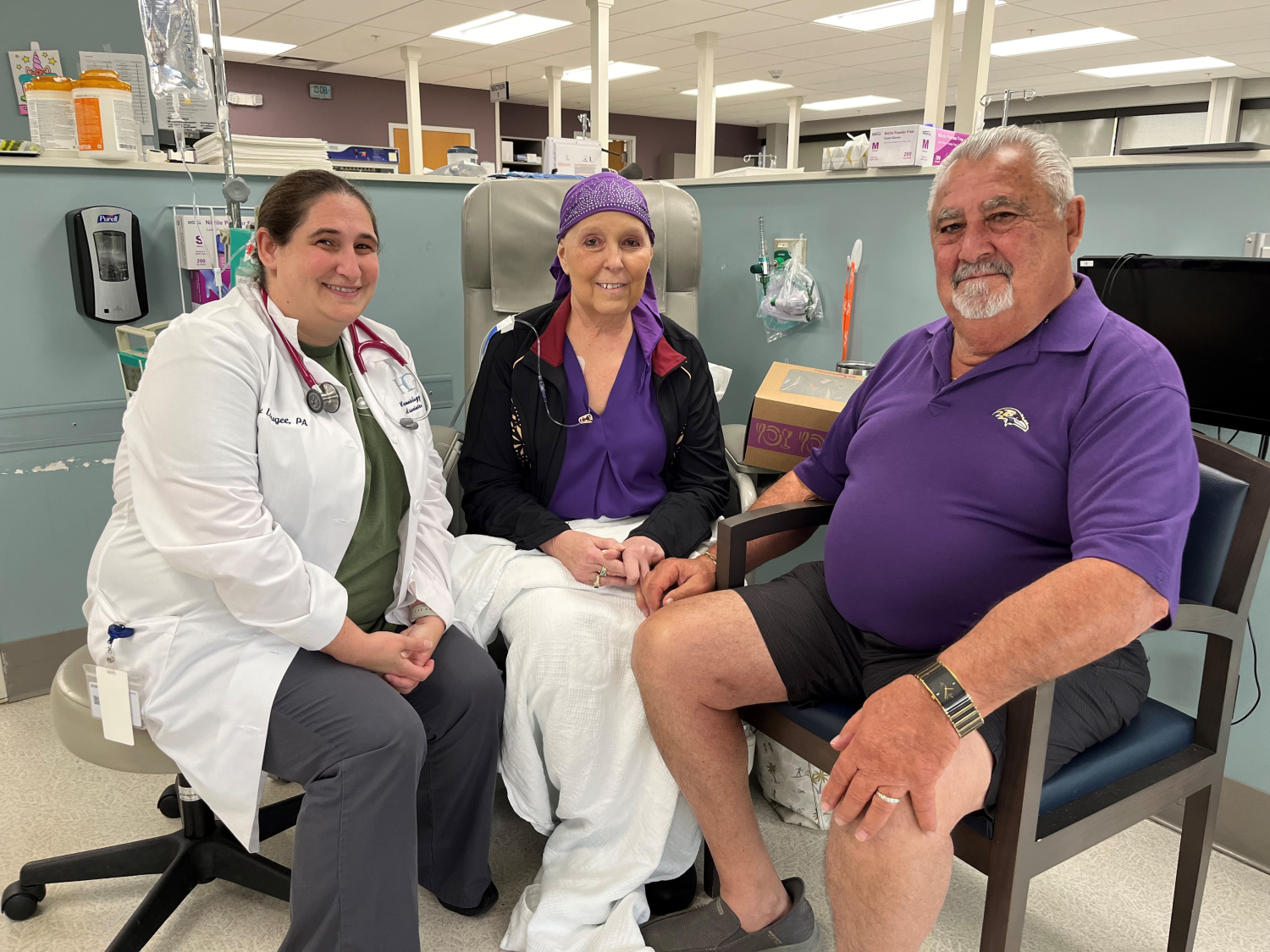CNY cancer practice plans to ramp up cutting-edge therapy after successful outpatient treatment

Gail Mauro (center) receives her final step-up dose of bispecific antibody therapy at Hematology-Oncology Associates of CNY. She is pictured here with her husband, Joe (right) along with HOA Physician Assistant and Clinical Manager Denise Lougee. Joe serves as Gail’s at-home caregiver, which is a requirement of this new program.
Courtesy of HOA
By
Syracuse, NY -- A cutting-edge cancer treatment that promises to control certain tumors after traditional methods fail is poised to reach more people in Central New York.
Hematology-Oncology Associates of CNY is now scheduling roughly one patient a week to begin bispecific antibody therapy, a treatment for some cancers that have stopped responding to chemotherapy and radiation.
Bispecific therapy is only available under certain, rare circumstances, doctors warn. It’s not a cure for cancer.
But here’s what’s new: eligible patients at the HOA practice can now get this specialized cancer treatment without a hospital admission.
That shift matters. Being able to care for a patient at home during treatment could eventually open the door for a much larger number of people to receive the therapy, an expert told syracuse.com | The Post-Standard.
“That is very, very new and innovative to be able to do in a non-hospital setting,” said Kathy Mooney, clinical program director of cellular therapy at Johns Hopkins Hospital in Baltimore.
HOA says its breakthrough in recent weeks marks the first time the therapy has been started outside a hospital anywhere in New York state.
And they won’t be the only ones for long. Upstate Cancer Center plans to begin doing the same in the near future, a spokesman said.
The switch to outpatient treatment is a step in the right direction, Mooney says. Over time, that means the treatment could be relatively cheaper and relatively easier to access.
Hospital treatments are much more expensive than outpatient ones, and require a hard-to-find inpatient bed, said Mooney, who has studied the rise in bispecific antibody therapy.
The relatively new therapy is not chemo or radiation. Instead, the drug binds itself to both cancer cells and immune system cells in an attempt to use the immune system to fight the cancer.
It’s been around for a couple of years now. And it’s shown success in stemming cancer growth in 40% to 60% of the toughest cases, an HOA doctor said.
That’s an impressive track record in controlling tumors that have proven resistant to other treatments, said Dr. Tarek J. Sousou, an HOA hematologist.
The treatment is still so new, however, that it’s not an option for everyone.
Right now, federal authorities have only approved the treatment for patients with myeloma, lymphoma, small cell lung cancer or uveal melanoma.
At HOA, only about 2,000 of the practice’s 20,000 patients have cancers that can be treated using bispecific therapy.
It’s also prescribed only when all other traditional treatments have failed, according to Jonas Congelli, a trained pharmacist who works as HOA’s chief strategy officer.
Unfortunately, that means some patients may not live long enough to receive this treatment, he said.
Before the recent breakthrough, HOA had sent roughly 20 patients receiving such treatments to a Rochester hospital for days at a time. Now, HOA patients can receive the same therapy without a hospital stay.
“We’re really in the beginning stages of bispecific therapy,” Sousou said. “I wonder how well this would work earlier in treatment?”
Typically, cancer therapies become available earlier in the fight after being proven effective over longer periods of time, Sousou said.
The number of cancers that bispecific therapy can treat is also expected to grow. Clinical trials are underway all the time, Congelli said. That, combined with advances in outpatient treatments, are paving the way for it to become available to more people in the future.
Before now, the therapy required three to four hospital stays of at least a couple days each time to begin the therapy. Those stays, spaced roughly two weeks apart, were needed to manage possible complications from the body’s immune system response to the initial doses.
Those complications, if they happen, are not considered life-threatening if treated immediately.
HOA has now successfully brought a small cell lung cancer patient through the initial doses. She suffered no setbacks.
The cancer group has since started two more patients on outpatient bispecific therapy.
There are requirements to receive such a therapy at home.
The patient must live within an hour of HOA’s East Syracuse office and Crouse Hospital, whose ER staff has been trained to handle any serious complications. The caregiver must check the patient’s blood pressure, pulse and temperature every four hours while awake. And HOA staff call the caregiver every eight hours during the initial dosing phase to check on the patient’s condition.
Despite the therapy’s promise, Sousou warned that it had its limits.
“The unfortunate nature of this is, it is not a cure,” he said.
On the other hand, simply stopping a tumor’s growth can add years to someone’s life.
“It’s very promising, but more work is needed,” he said.
